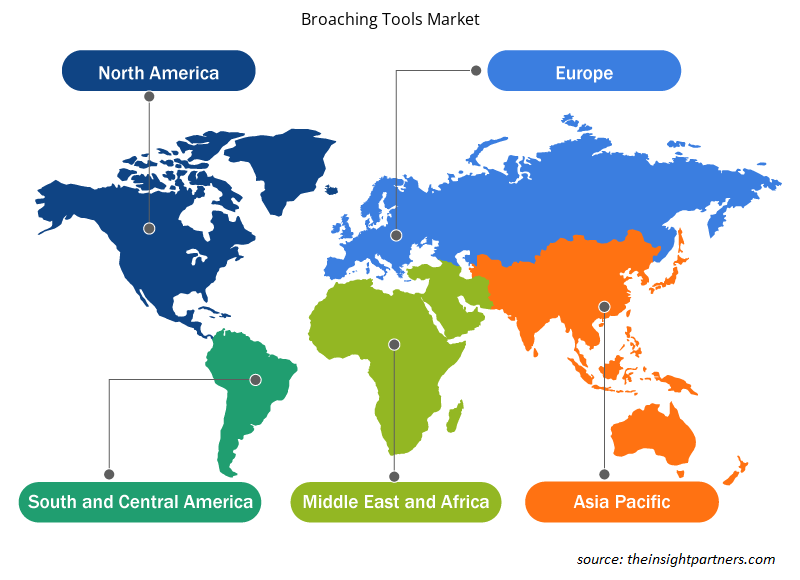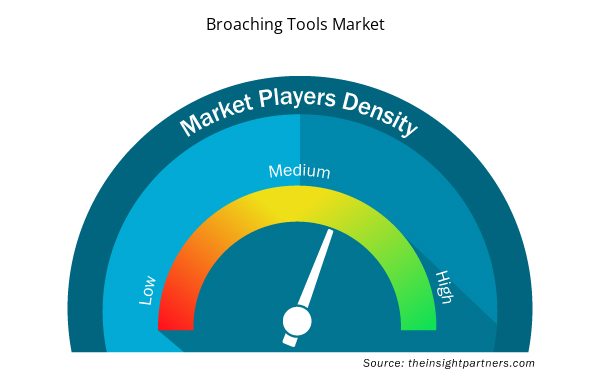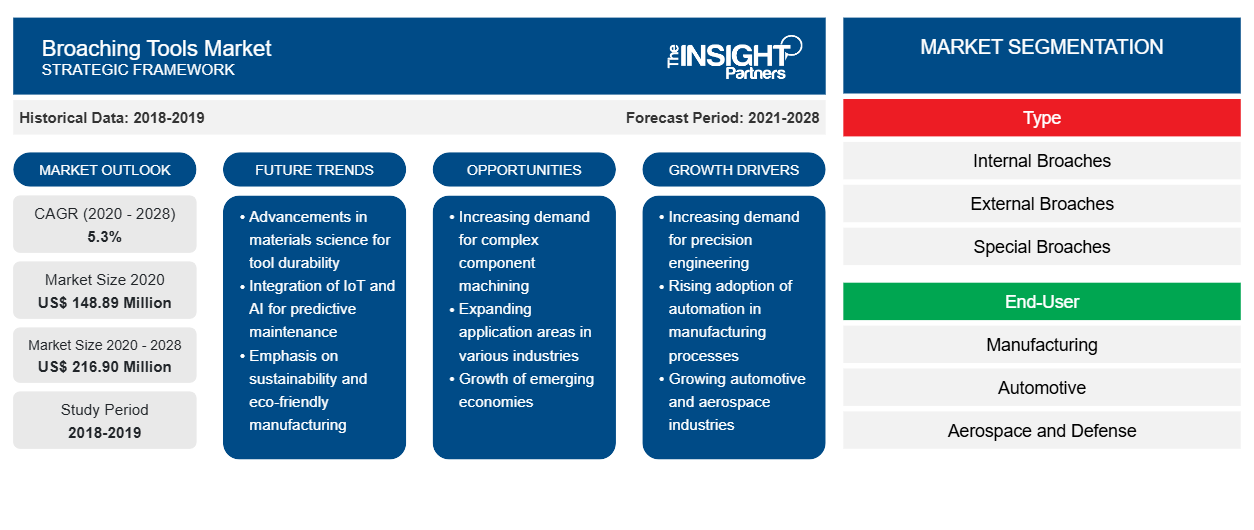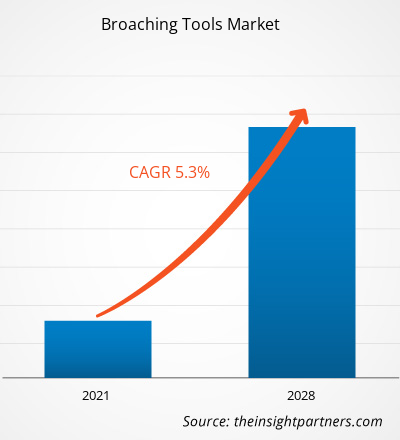Der Markt für Räumwerkzeuge wurde im Jahr 2020 auf 148,89 Millionen US-Dollar geschätzt und soll bis 2028 216,90 Millionen US-Dollar erreichen; für den Zeitraum 2021–2028 wird ein durchschnittliches jährliches Wachstum von 5,3 % erwartet.
Aufgrund des globalen Wirtschaftswachstums hat der Fertigungssektor in den letzten zwei Jahrzehnten erheblich an Bedeutung gewonnen, insbesondere in den Schwellenländern im asiatisch-pazifischen Raum. Räumwerkzeuge werden häufig zur Herstellung verschiedener Industriekomponenten und Baugruppenteile verwendet. Die steigende Nachfrage nach schnellen und präzisen Endbearbeitungsprozessen aus den Endverbrauchssektoren wie Automobil, Luft- und Raumfahrt, Verteidigung und Bauwesen ermutigt die Hersteller von Räumwerkzeugen, fortschrittliche Werkzeuge auf den Markt zu bringen. Der Fertigungssektor ist einer der wichtigsten Wirtschaftswachstumsmotoren in der Region Asien-Pazifik. Faktoren wie niedrige Arbeitskosten, eine zunehmend junge Bevölkerung und staatliche Leistungen in Form von Tochtergesellschaften und Steuererleichterungen ziehen Unternehmen an, größere Fertigungsstandorte in der Region Asien-Pazifik aufzubauen. Darüber hinaus treiben staatliche Initiativen wie „Made in China 2025“ und „Make in India“ das Wachstum des Fertigungssektors in der Region Asien-Pazifik voran. Darüber hinaus führt das wachsende verfügbare Einkommen der Massen zu einer zunehmenden Übernahme des modernen Lebensstils in der Region, was die Nachfrage nach Unterhaltungselektronik und Autos ankurbelt. Dieser Faktor stärkt den Fertigungssektor. Daher treibt der wachsende Fertigungssektor das Wachstum des Marktes für Räumwerkzeuge in der Region Asien-Pazifik voran.
Passen Sie diesen Bericht Ihren Anforderungen an
Sie erhalten kostenlos individuelle Anpassungen an jedem Bericht, einschließlich Teilen dieses Berichts oder einer Analyse auf Länderebene, eines Excel-Datenpakets sowie tolle Angebote und Rabatte für Start-ups und Universitäten.
- Holen Sie sich die wichtigsten Markttrends aus diesem Bericht.Dieses KOSTENLOSE Beispiel umfasst eine Datenanalyse von Markttrends bis hin zu Schätzungen und Prognosen.
Auswirkungen der COVID-19-Pandemie auf den Markt für Räumwerkzeuge
Der COVID-19-Ausbruch wirkt sich negativ auf die Industrien weltweit aus und dieser verheerende Effekt hält auch im Jahr 2021 an. Der Ausbruch verursachte erhebliche Störungen in Primärindustrien wie Fertigung, Gesundheitswesen, Energie und Strom, Elektronik und Halbleiter, Luft- und Raumfahrt und Verteidigung sowie Bauwesen. Ein erheblicher Rückgang der Aktivitäten in den genannten Branchen wirkt sich negativ auf die Leistung des Marktes für Räumwerkzeuge aus . Die erneute Einführung von Eindämmungsmaßnahmen wie Reisebeschränkungen, Handelsverboten und Personalbeschränkungen am Arbeitsplatz hat die Herstellung, Versorgung und den Verkauf verschiedener Unternehmen, einschließlich Industrieausrüstung wie Räumwerkzeuge, gestört.
Einblicke in den Markt für Räumwerkzeuge
Steigende Automobilproduktion
In den letzten Jahren ist die Nachfrage nach hochwertigen Autos gestiegen, was zu einer erhöhten Fahrzeugproduktion geführt hat, vor allem in entwickelten Regionen wie Nordamerika und Europa. Darüber hinaus steigt die Nachfrage nach Nutzfahrzeugen und Personenkraftwagen, vor allem in Entwicklungsländern. Räumwerkzeuge werden im Automobilsektor häufig zur Herstellung von Zahnrädern, Getriebewellen, Lenkradnaben, Lenkgabeln und mehr eingesetzt. Laut dem Center for Automotive Research, einer gemeinnützigen Organisation, investierten Autohersteller wie FCA, GM, Ford, Hyundai, Nissan, Volkswagen und Toyota im Jahr 2018 4,8 Milliarden US-Dollar in die Automobilindustrie. Darüber hinaus sind die Investitionen in Forschung und Entwicklung (F&E) in der Automobilindustrie in Europa um 6,7 % auf 67,09 Milliarden US-Dollar pro Jahr gestiegen. Die steigende Nachfrage nach hochwertigen Fahrzeugen und die zunehmende Fahrzeugproduktion fördern also den Einsatz von Räumwerkzeugen in der Automobilindustrie.
Typbasierte Markteinblicke
Der Markt für Räumwerkzeuge ist nach Typ in Innen-, Außen- und Spezial-Räumwerkzeuge unterteilt. Das Segment Innen-Räumwerkzeuge hatte im Jahr 2020 den größten Anteil. Aufgrund der steigenden Nachfrage nach vertikalen Räummaschinen wird erwartet, dass der Markt für Innen-Räumwerkzeuge im Prognosezeitraum schneller wächst. Die Innenräumtechnik wird häufig zur Herstellung verschiedener Präzisionskomponenten verwendet, wie z. B. Automobil- und Maschinenzahnräder, Schusswaffenkomponenten und Befestigungselemente. Mit dem stetigen Wachstum der Industrialisierung auf der ganzen Welt wird erwartet, dass der Markt für Räumwerkzeuge im Prognosezeitraum ein deutliches Wachstum verzeichnen wird.
Die Akteure auf dem Markt für Räumwerkzeuge konzentrieren sich auf Strategien wie Fusionen, Übernahmen und Marktinitiativen, um ihre Positionen auf dem Markt zu behaupten. Nachfolgend sind einige Entwicklungen der wichtigsten Akteure aufgeführt:
- Im Jahr 2020 brachte die Blohm Jung GmbH die PROFIMAT XT mit Werkzeugwechsler auf den Markt. Das Werkzeug ermöglicht einen automatischen Wechsel der Schleifscheiben. Diese flexible PROFIMAT XT vereint vier Schleiftechnologien in einer Maschine: Pendel-, Tiefgang-, CD- und Schnellhubschleifen.
- Im Jahr 2018 stellte die Blohm Jung GmbH auf der IMTS ihr neues Produkt namens PROFIMAT XT als Weltpremiere vor. Diese Markteinführung ist eine Erweiterung ihres Schleifmaschinenportfolios.
Regionale Einblicke in den Markt für Räumwerkzeuge
Die regionalen Trends und Faktoren, die den Markt für Räumwerkzeuge während des Prognosezeitraums beeinflussen, wurden von den Analysten von Insight Partners ausführlich erläutert. In diesem Abschnitt werden auch die Marktsegmente und die Geografie für Räumwerkzeuge in Nordamerika, Europa, im asiatisch-pazifischen Raum, im Nahen Osten und Afrika sowie in Süd- und Mittelamerika erörtert.

- Erhalten Sie regionale Daten zum Markt für Räumwerkzeuge
Umfang des Marktberichts zu Räumwerkzeugen
| Berichtsattribut | Details |
|---|---|
| Marktgröße im Jahr 2020 | 148,89 Millionen US-Dollar |
| Marktgröße bis 2028 | 216,90 Millionen US-Dollar |
| Globale CAGR (2020 - 2028) | 5,3 % |
| Historische Daten | 2018-2019 |
| Prognosezeitraum | 2021-2028 |
| Abgedeckte Segmente | Nach Typ
|
| Abgedeckte Regionen und Länder | Nordamerika
|
| Marktführer und wichtige Unternehmensprofile |
|
Marktteilnehmerdichte: Der Einfluss auf die Geschäftsdynamik
Der Markt für Räumwerkzeuge wächst rasant, angetrieben durch die steigende Nachfrage der Endnutzer aufgrund von Faktoren wie sich entwickelnden Verbraucherpräferenzen, technologischen Fortschritten und einem größeren Bewusstsein für die Vorteile des Produkts. Mit steigender Nachfrage erweitern Unternehmen ihr Angebot, entwickeln Innovationen, um die Bedürfnisse der Verbraucher zu erfüllen, und nutzen neue Trends, was das Marktwachstum weiter ankurbelt.
Die Marktteilnehmerdichte bezieht sich auf die Verteilung der Firmen oder Unternehmen, die in einem bestimmten Markt oder einer bestimmten Branche tätig sind. Sie gibt an, wie viele Wettbewerber (Marktteilnehmer) in einem bestimmten Marktraum im Verhältnis zu seiner Größe oder seinem gesamten Marktwert präsent sind.
Die wichtigsten auf dem Markt für Räumwerkzeuge tätigen Unternehmen sind:
- Amerikanische Broach & Machine Company
- Arthur Klink GmbH
- Weitere Informationen.
- Ekin S Genossenschaft
- Blohm Jung GmbH
Haftungsausschluss : Die oben aufgeführten Unternehmen sind nicht in einer bestimmten Reihenfolge aufgeführt.

- Überblick über die wichtigsten Akteure auf dem Markt für Räumwerkzeuge
Der globale Markt für Räumwerkzeuge ist wie folgt segmentiert:
Markt für Räumwerkzeuge – nach Typ
- Innenräumnadeln
- Außenräumnadeln
- Sonder-Räumnadeln
Markt für Räumwerkzeuge – nach Endbenutzer
- Herstellung
- Automobilindustrie
- Luft- und Raumfahrt & Verteidigung
- Konstruktion
- Sonstiges
Markt für Räumwerkzeuge – nach Geografie
Nordamerika
- UNS
- Kanada
- Mexiko
Europa
- Frankreich
- Deutschland
- Italien
- Russland
- Vereinigtes Königreich
- Restliches Europa
Asien-Pazifik (APAC)
- China
- Indien
- Japan
- Australien
- Südkorea
- Restlicher Asien-Pazifik-Raum
Naher Osten und Afrika (MEA)
- Saudi-Arabien
- Vereinigte Arabische Emirate
- Südafrika
- Rest von MEA
Südamerika (SAM)
- Brasilien
- Argentinien
- Rest von SCAM
Firmenprofile
- Amerikanische Broach & Machine Company
- Arthur Klink GmbH
- Weitere Informationen.
- Ekin S Genossenschaft
- Blohm Jung GmbH
- Messer Räumtechnik GmbH & Co. KG
- Mitsubishi Heavy Industries Machine Tool Co., Ltd.
- Nachi-Fujikoshi Corp.
- Die Broach Masters, Inc.
- Miller-Brosche
- Historische Analyse (2 Jahre), Basisjahr, Prognose (7 Jahre) mit CAGR
- PEST- und SWOT-Analyse
- Marktgröße Wert/Volumen – Global, Regional, Land
- Branche und Wettbewerbsumfeld
- Excel-Datensatz



Report Coverage
Revenue forecast, Company Analysis, Industry landscape, Growth factors, and Trends

Segment Covered
This text is related
to segments covered.

Regional Scope
North America, Europe, Asia Pacific, Middle East & Africa, South & Central America

Country Scope
This text is related
to country scope.
Häufig gestellte Fragen
The carbide tools market is led by internal broaches segment is expected to dominate in the forecast period. Internal broaching is a process of sharping the inside surface of the workpiece. Internal broaching consists of two techniques: rotary broaching and vertical broaching. A rotating broach tool is used in rotary broaching technique for sharping the internal surface of workpiece, while vertical broaching uses push or pull-down applications for sharping the internal surface of workpiece. The internal broaching technique is widely used for producing various precision components, such as automobile and machinery gears, firearm components, and fasteners. With the steady growth of industrialization across the world, the broaching tools market is expected to witness a significant growth during the forecast period.
Rising automotive production is driving the demand for broaching tools. In recent years, there is an increase in demand for high-end automotive, resulting in increased vehicle production, mainly in the developed regions such as North America and Europe. Moreover, the demand for commercial vehicles and passenger cars, primarily in developing nations, is increasing. Broaching tools are widely utilized in automotive sector to manufacture gears, transmission shafts, steering wheel hubs, steering yokes, and others. According to the Center for Automotive Research, a non-profit organization, in 2018, automakers such as FCA, GM, Ford, Hyundai, Nissan, Volkswagen, and Toyota invested US$ 4.8 billion in the automotive industry. In addition, automotive investment in research and development (R&D) has increased by 6.7% to reach US$ 67.09 billion annually in Europe. Thus, rising demand for high-end vehicles and increasing vehicle production is boosting the adoption of broaching tools in the automotive industry.
The rapid change in modern warfare has been urging the governments to allocate higher funds toward respective military forces. The higher military budget allocation enables the military forces to engage themselves in the development of robust arms and ammunition, indigenous technologies, rugged devices, and various other technologies. At present, the soldier and military vehicle modernization practices are peaking among most military forces to keep the personnel and vehicles ready for mission. With an objective to modernize armed forces, ministries across the world are investing substantial amounts. Countries such as the US, China, India, Russia, Saudi Arabia, France, and Germany are increasing their defense budgets year-on-year. The broaching tools are widely used in manufacturing various components of arms and ammunition, armed vehicles, military aircrafts, battle tanks, IFVs, and communication and computing devices. Thus, increasing defense budget will subsequently create growth opportunities for market players.
Trends and growth analysis reports related to Manufacturing and Construction : READ MORE..
The List of Companies - Broaching Tools Market
- American Broach & Machine Company
- Arthur Klink GmbH
- Colonial Tool Group Inc.
- Ekin S coop
- Blohm Jung GmbH
- Messer Räumtechnik GmbH & Co. KG
- Mitsubishi Heavy Industries Machine Tool Co., Ltd.
- Nachi-Fujikoshi Corp.
- The Broach Masters, Inc.
- Miller Broach
The Insight Partners performs research in 4 major stages: Data Collection & Secondary Research, Primary Research, Data Analysis and Data Triangulation & Final Review.
- Data Collection and Secondary Research:
As a market research and consulting firm operating from a decade, we have published and advised several client across the globe. First step for any study will start with an assessment of currently available data and insights from existing reports. Further, historical and current market information is collected from Investor Presentations, Annual Reports, SEC Filings, etc., and other information related to company’s performance and market positioning are gathered from Paid Databases (Factiva, Hoovers, and Reuters) and various other publications available in public domain.
Several associations trade associates, technical forums, institutes, societies and organization are accessed to gain technical as well as market related insights through their publications such as research papers, blogs and press releases related to the studies are referred to get cues about the market. Further, white papers, journals, magazines, and other news articles published in last 3 years are scrutinized and analyzed to understand the current market trends.
- Primary Research:
The primarily interview analysis comprise of data obtained from industry participants interview and answers to survey questions gathered by in-house primary team.
For primary research, interviews are conducted with industry experts/CEOs/Marketing Managers/VPs/Subject Matter Experts from both demand and supply side to get a 360-degree view of the market. The primary team conducts several interviews based on the complexity of the markets to understand the various market trends and dynamics which makes research more credible and precise.
A typical research interview fulfils the following functions:
- Provides first-hand information on the market size, market trends, growth trends, competitive landscape, and outlook
- Validates and strengthens in-house secondary research findings
- Develops the analysis team’s expertise and market understanding
Primary research involves email interactions and telephone interviews for each market, category, segment, and sub-segment across geographies. The participants who typically take part in such a process include, but are not limited to:
- Industry participants: VPs, business development managers, market intelligence managers and national sales managers
- Outside experts: Valuation experts, research analysts and key opinion leaders specializing in the electronics and semiconductor industry.
Below is the breakup of our primary respondents by company, designation, and region:

Once we receive the confirmation from primary research sources or primary respondents, we finalize the base year market estimation and forecast the data as per the macroeconomic and microeconomic factors assessed during data collection.
- Data Analysis:
Once data is validated through both secondary as well as primary respondents, we finalize the market estimations by hypothesis formulation and factor analysis at regional and country level.
- Macro-Economic Factor Analysis:
We analyse macroeconomic indicators such the gross domestic product (GDP), increase in the demand for goods and services across industries, technological advancement, regional economic growth, governmental policies, the influence of COVID-19, PEST analysis, and other aspects. This analysis aids in setting benchmarks for various nations/regions and approximating market splits. Additionally, the general trend of the aforementioned components aid in determining the market's development possibilities.
- Country Level Data:
Various factors that are especially aligned to the country are taken into account to determine the market size for a certain area and country, including the presence of vendors, such as headquarters and offices, the country's GDP, demand patterns, and industry growth. To comprehend the market dynamics for the nation, a number of growth variables, inhibitors, application areas, and current market trends are researched. The aforementioned elements aid in determining the country's overall market's growth potential.
- Company Profile:
The “Table of Contents” is formulated by listing and analyzing more than 25 - 30 companies operating in the market ecosystem across geographies. However, we profile only 10 companies as a standard practice in our syndicate reports. These 10 companies comprise leading, emerging, and regional players. Nonetheless, our analysis is not restricted to the 10 listed companies, we also analyze other companies present in the market to develop a holistic view and understand the prevailing trends. The “Company Profiles” section in the report covers key facts, business description, products & services, financial information, SWOT analysis, and key developments. The financial information presented is extracted from the annual reports and official documents of the publicly listed companies. Upon collecting the information for the sections of respective companies, we verify them via various primary sources and then compile the data in respective company profiles. The company level information helps us in deriving the base number as well as in forecasting the market size.
- Developing Base Number:
Aggregation of sales statistics (2020-2022) and macro-economic factor, and other secondary and primary research insights are utilized to arrive at base number and related market shares for 2022. The data gaps are identified in this step and relevant market data is analyzed, collected from paid primary interviews or databases. On finalizing the base year market size, forecasts are developed on the basis of macro-economic, industry and market growth factors and company level analysis.
- Data Triangulation and Final Review:
The market findings and base year market size calculations are validated from supply as well as demand side. Demand side validations are based on macro-economic factor analysis and benchmarks for respective regions and countries. In case of supply side validations, revenues of major companies are estimated (in case not available) based on industry benchmark, approximate number of employees, product portfolio, and primary interviews revenues are gathered. Further revenue from target product/service segment is assessed to avoid overshooting of market statistics. In case of heavy deviations between supply and demand side values, all thes steps are repeated to achieve synchronization.
We follow an iterative model, wherein we share our research findings with Subject Matter Experts (SME’s) and Key Opinion Leaders (KOLs) until consensus view of the market is not formulated – this model negates any drastic deviation in the opinions of experts. Only validated and universally acceptable research findings are quoted in our reports.
We have important check points that we use to validate our research findings – which we call – data triangulation, where we validate the information, we generate from secondary sources with primary interviews and then we re-validate with our internal data bases and Subject matter experts. This comprehensive model enables us to deliver high quality, reliable data in shortest possible time.


 Holen Sie sich ein kostenloses Muster für diesen Bericht
Holen Sie sich ein kostenloses Muster für diesen Bericht